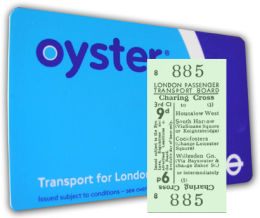Posted 1st July 2013 | 3 Comments
Unified London transport celebrates 80 years

UNIFIED transport in London reached its 80th anniversary on 1 July. The London Passenger Transport Board took over from privately-owned rail and road operators on 1 July 1933, when the Underground was significantly smaller than it is now but the capital still had a complex tram network.
Another anniversary occurred on 30 June, when the Oyster smartcard celebrated its tenth birthday.
Transport in London was unified in 1933 but not nationalised. It had issued interest-bearing stock to compensate the individual operators whose businesses had been absorbed into London Transport. Only the main line railways and taxis remained outside LT's public transport remit.
Nationalisation followed on 1 January 1948, when the LPTB became the London Transport Executive, part of the British Transport Commission.
By now many of the trams had gone and Underground extensions had been built, but some modernisation had been delayed by the war.
The LTE changed again into a Board directly answerable to the Minister of Transport at the start of 1963, but evolved into a second-generation London Transport Executive on 1 January 1970, run by the Greater London Council.
Bitter fares wars followed, as GLC leader Ken Livingstone's fare cuts were resisted by some of the outer London boroughs, one of which achieved victory in a famous House of Lords ruling.
In spite of the political strife, the main part of the Victoria Line was opened in 1969, and another new line – the Jubilee – followed ten years later. In 1999 this was extended from central London eastwards to Docklands and Stratford.
When the Greater London Council ceased to exist, LT was dubbed London Regional Transport in 1985, but more ambitious plans for reforming London local government meant that a new organisation, to be known as Transport for London, was created at the end of the 1990s, to be controlled by the new executive Mayor and monitored by the London Assembly.
A fresh controversy over public-private partnerships intended to involve the private sector in Underground maintenance and renewals delayed the handover of the Underground to TfL, because the new Mayor Ken Livingstone was opposed to them. However, once the contracts had been signed the last of the transfers took place, and London Regional Transport was wound up on 15 July 2003. Both the PPP contracts later failed, and are now once again part of the core Underground.
Transport for London has a wider bnef than any of its predecessors, being responsible for the Underground, Overground, Docklands Light Railway, trams, buses, taxis, streets, river services, Victoria coach station, bicycle hire and most recently a cable car across the Thames.
The government has just announced that some West Anglia National Rail routes are to be devolved to TfL by the end of 2015, when the first trains operated by the new Crossrail concession-holder are due to start running on the line between Liverpool Street and Shenfield. The rest of Crossrail, which will also be a TfL service, is scheduled to open in 2018 and 2019, while £2 million has just been provided by the government to fund the first planning stage of Crossrail 2.
In the ten years since Oyster smartcards were launched on 30 June 2003, around 60 million cards have been issued and over 85 percent of all rail and bus travel in London is paid for using the cards.
Reader Comments:
Views expressed in submitted comments are that of the author, and not necessarily shared by Railnews.

jbzoom, Guildford
The destruction of Britain's train-manufacturing industry was a joint achievement of both major parties over decades. In France, Germany, Italy and Spain the railways buy trains steadily and thereby sustain the domestic industry. In Britain years of doing nothing are punctuated by sporadic large orders, many of which have gone abroad. After losing Birmingham and York and leaving only Derby as a train manufacturing centre, we have lured the Japanese, with a screwdriver plant in the North-East. It was a daft labour procurement that led to Siemens supplying German trains for Thameslink. Now the Germans, the Japanese/Geordies and Bombardier's Derby factory are competing for the Crossrail order. Both Derby and the North-East need the order - let's see what happens.
Melvyn Windebank, Canvey Island, Essex
If only the original plans had also include main lines within London Transports realm we would now have a far bigger overground network with no doubt many old stations upgraded from the Victorian state many still have !
We might have even seen more joined together creating versions of Crossrail and Thameslink and maybe the Victoria Line might have been built to main line gauge with all the extra capacity that would have brought.
However, looking at how pre-war London Transport worked and the massive investment and expansion of the UndergrounD undertaken which was funded not by fancy PPP but by Bonds similar to what Mayor Ken Livingstone wanted perhaps with Crossrail 2 and other schemes its time to issue either TFL or Mayoral bonds to fund only Capital Investment projects and thus tap the billions of funds that are looking for somewhere to invest!
Perhaps its time to get back to doing things like they did in the old days as looking at pre war London Transport lines and stations they have stood the test of time it's just a pity they forgot to install lifts for access but the world was different then I suppose .
jack99, Oxford
A real success story and all its trains are British built ( except for the Croydon trams ) - Now thats what you call putting money back into UK plc unlike Mr Cameron who is re-balancing the UK economy by giving train orders to Germany - Mrs Merkel must be laughing her head off at Mr Cameron's stupidity.